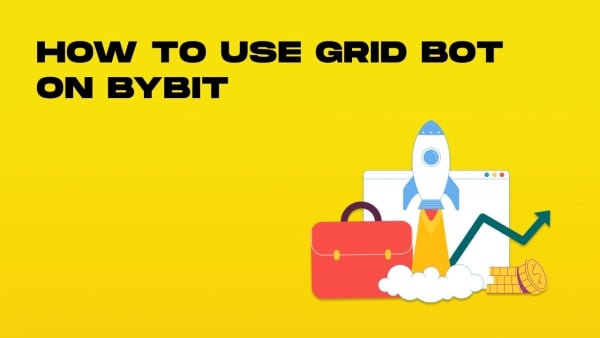What Is Grid Trading and Why Use It?
Grid trading is one of the most effective trading strategies that divides your price range into multiple “grids” where the bot places buy and sell orders. It’s like setting up a net to catch profits as prices move up and down.
Key benefits of using Bybit’s Grid Bot:
-
Works in any market condition (especially sideways markets)
-
Runs 24/7 without requiring your attention
-
No coding or technical skills needed
-
Helps you earn in market conditions where HODLing fails
-
Manages risk through clear parameters you control
Types of Grid Bots on Bybit
Bybit offers three types of Grid Bots to match your strategy and market outlook:
| Bot Type | Best Used When | Key Feature |
|---|---|---|
| Arithmetic Grid | Market moves sideways | Equal price distance between grids |
| Geometric Grid | Market is trending | Equal percentage between grids |
| Inverse Grid | Market is bearish | Accumulates more as price drops |
Bybit also offers a Futures Grid Bot, which is designed for trading in the futures market with the ability to utilize leverage.
Setting Up Your First Grid Bot: Step-by-Step
Step 1: Access the Grid Bot Feature
-
Log into your Bybit account
-
Navigate to the USDT Perpetual Trading Page under the “Derivatives” section
-
Click on “Trading Bots” in the top menu
-
Select “Grid Bot” from the options
Step 2: Choose Your Trading Pair
-
Select the cryptocurrency pair you want to trade (e.g., BTC/USDT)
-
Choose between Spot Trading or Futures market (beginners should start with Spot Trading)
Step 3: Select Your Grid Strategy
-
Choose between Arithmetic, Geometric, or Inverse Grid
-
For beginners, Arithmetic works best in sideways markets. For more advanced users, consider using the Long Mode to capitalize on upward market trends.
Step 4: Set Your Grid Parameters
-
Define your price range (upper and lower limits)
-
Set the number of grids (more grids = more frequent trades but smaller profits per trade)
-
Input your investment amount (start small if you’re a beginner)
-
Set your Stop Loss limit to manage risk and automatically sell a position when it reaches a predetermined loss percentage.
-
Review the estimated APR (Annual Percentage Return) provided by Bybit
Step 5: Launch Your Bot
-
Review all parameters one final time
-
Click “Create Grid Bot” to finalize the setup. Your bot will be created and begin placing orders immediately
-
Your bot will initialize and begin placing orders immediately
Optimizing Your Grid Bot for Maximum Profits
The difference between a profitable grid bot and a losing one often comes down to these optimization techniques:
Utilize advanced settings to fine-tune your bot's performance and manage risk effectively.
Finding the Right Price Range
Set your upper and lower limits based on recent support and resistance levels to adapt to price fluctuations. For volatile assets like Bitcoin, consider a wider range (15-20%). For stable assets, a narrower range (5-10%) often works better.
Choosing the Optimal Number of Grids
More grids mean more potential trades but smaller profit per trade:
-
20-40 grids: Good starting point for beginners
-
40-80 grids: For more active markets with higher volatility
-
80+ grids: For experienced traders in highly volatile markets
Keep in mind that more grids can lead to higher trading fees due to the increased number of trades.
Selecting the Right Investment Amount
Start with 5-10% of your total investment capital until you understand how the bot performs. You can increase this as you gain confidence.
Monitoring and Managing Your Grid Bot
How to Track Performance
-
Go to the “Grid Bot” section under “Trading Bots” on the right side of the page
-
Check the “Active Bots” tab to see running bots
-
View detailed metrics including:
-
Total profit (in USDT and %)
-
Number of completed grid trades
-
Current APR
When to Stop or Modify Your Bot
Consider stopping or adjusting your bot when:
-
The market breaks out of your defined range
-
A major news event could cause extreme volatility
-
Your bot has reached your profit target
-
The trading pair fundamentals have changed
If your bot is terminated due to insufficient funds, any remaining funds will be returned to your Funding Account.
Grid Bot Strategies for Different Market Conditions
For Sideways (Ranging) Markets
Use an Arithmetic Grid with a narrow price range (5-15%) based on recent support and resistance levels. Increase grid numbers to 50+ for more frequent trades. The neutral mode is also suitable for sideways markets, allowing you to manage risk effectively.
For Bullish Markets
Set up a Geometric Grid with a wider upper limit to capture the rise in prices and upward momentum. Use fewer grids (20-40) with a larger investment to capitalize on the uptrend.
For Bearish Markets
The Inverse Grid Bot shines here, accumulating more assets as prices fall. Set your lower limit conservatively, as bear markets can extend further than expected. The Inverse Grid Bot can help recover from incurring losses by accumulating more assets as prices fall.
Common Grid Bot Mistakes to Avoid
Don’t sabotage your grid bot profits with these common errors:
-
Setting unrealistic price ranges - Always base ranges on technical analysis, not wishful thinking
-
Using too little capital - Grid bots need sufficient funds to operate effectively across all grids
-
Ignoring market trends - Grid bots work best when matched to current market conditions
-
Setting and forgetting - Even automated bots need periodic reviews and adjustments
-
Starting with high-risk pairs - Begin with major pairs (BTC/USDT, ETH/USDT) before experimenting with altcoins
Careful investing and disciplined decision-making are crucial to avoid these common mistakes.
Advanced Grid Bot Tactics
Once you’re comfortable with the basics, these advanced tactics can boost your returns:
Consider using the Futures Combo Bot to manage multiple futures contracts within a single portfolio, offering features like automatic rebalancing and customizable settings. This versatile trading tool supports both manual and AI configuration, making it suitable for traders with diverse strategies who prefer to simplify their trading experience.
Multiple Bot Strategy
Run several grid bots with different parameters on the same pair to cover wider market scenarios, or across different trading pairs to diversify risk.
You can also explore other bots like the Futures Combo Bot to diversify your trading strategies.
Time-Based Adjustments
Schedule regular reviews of your grid bot (weekly for volatile markets, monthly for stable ones) and adjust parameters based on changing market conditions. Regularly update your bot with new parameters to adapt to changing market conditions.
Combining with Manual Trading
Use grid bots for baseline profits while manually trading during major market moves that exceed your grid parameters.
Use manual trading to maintain positions and avoid liquidation during major market moves.
Conclusion: Is Grid Trading Right for You?
Bybit trading bot offers a powerful way to automate your crypto trading and potentially earn profits in any market condition - especially when prices move sideways.
If you’re willing to spend 10 minutes setting up parameters and can resist the urge to constantly fiddle with your strategy, grid trading might be your path to more consistent crypto returns.
Start small, focus on major pairs, and gradually optimize your approach as you gain experience. The most successful grid traders are those who match their bot parameters to realistic market expectations rather than chasing the highest theoretical APR.
Start your first Grid Bot on Bybit now and put your crypto to work - even while you sleep.
























